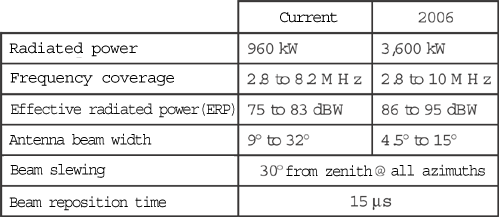The HAARP facility becomes operational, with a radiated power of 960 kW.
Introduction: Electromagnetic waves in certain frequency ranges are absorbed or refracted by the ionosphere, an electrically conductive region of the upper atmosphere beginning at an altitude of approximately 80 km. Radio waves of sufficient energy density are capable of temporarily modifying its electrical and physical properties within a small volume, enabling a new type of interactive research having application to a variety of Navy and DOD missions. The High Frequency Active Auroral Research Program, jointly sponsored by the Office of Naval Research, the Air Force Research Laboratory, and DARPA, is constructing a new interactive ionospheric research facility in Gakona, Alaska, to conduct both basic and applied research in this scientific discipline. We present a description of the major components of the HAARP Gakona Facility including technical detail of its current and planned performance capabilities. We also present some results from three research areas: extremely low and very low frequencies (ELF/VLF) generation, artificial optical emissions, and space research.
Facility Description: The HAARP Gakona Facility is located in a relatively remote region of south central Alaska where a variety of ionospheric conditions may occur, ranging from quiet to mid-latitude to auroral. The major feature of the facility is the high frequency (HF) phased array antenna, currently consisting of 48 elements. When completed in 2006, this array will consist of 180 elements with performance parameters as shown in Table 1 (below).
The facility also includes a suite of 17 on-site scientific and diagnostic instruments including magnetometers, riometers, a digisonde, and three upper atmospheric radars. Work has begun on an incoherent scatter radar. Since becoming operational in March 1999, the HAARP Gakona Facility has been used in 27 research campaigns. Figure 5 is an overhead photo of the facility. [1]































